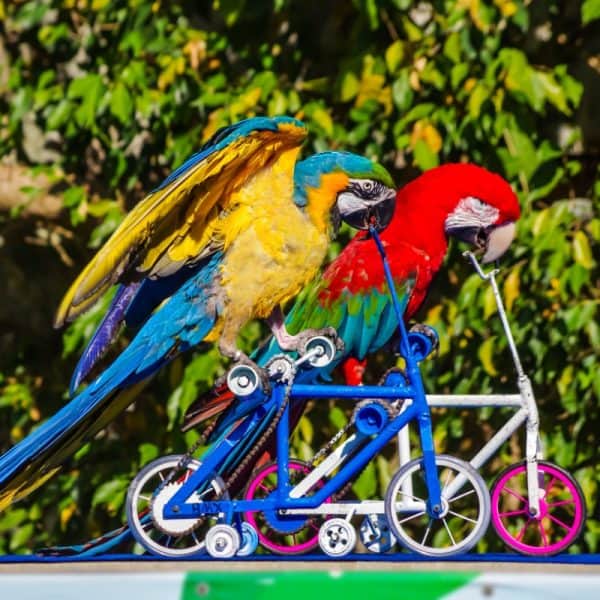Last Updated on by Mitch Rezman
The Police featuring Sting, one of my favorite artists (and groups) were singing a great little ditty the other day on satellite radio and it got me thinking. The name of the song was Canary In A Coal Mine.
The theme of the song was “you live your life like a canary in a coal mine”. We’ve all had friends like that, but I digress.
For the unindoctrinated or too young to know about this, years ago caged canaries were brought down into coal mine shafts.
They acted as the first warning sign that oxygen was being depleted and replaced with dangerous gases such as methane or carbon monoxide. Their method of warning the coal miners – was to die (in most cases).
Believe it or not, canaries were still used in coal mines up until December 30, 1986. On that date, a little over 200 birds were put out of work (with no benefits to draw on) and replaced with the latest and greatest carbon monoxide detectors.
One company CanarySense.com makes all its detectors and canary yellow, kind of like paying homage to the canaries that gave their lives.
A dude known as the father of oxygen therapy named John Haldae was in fact his own best guinea pig in the mid-1800s.
He studied oxygen rejuvenation and gas poisoning. He felt: “it could be safer using canaries or mice to detect gas in coal mines”.

Turns out that canaries need more oxygen and are more sensitive to toxic gases through their unique anatomy. Both the aforementioned gases have no color or odor.
If we were to breathe in carbon monoxide directly, it would bind to our red blood cells. Then this heinous gas will actually prevent your hemoglobin’s ability to carry oxygen resulting in fatigue, chest pain, and the inability to concentrate. (I find concentration elusive sometimes myself anyway).
Canaries were a great choice because they reacted quickly to the gas. Some humane miners would even go as far as carrying small oxygen vials to revive the birds before returning with them to the surface.
Better a canary than a miner, and so it went. The next time you see a lovely little canary singing his heart out you’ll remember what its ancestors withstood.

The canary thing then begged the question, what other birds have been put to use for tasks other than for our own enjoyment?
Surely these amazing winged creatures must have a higher purpose in life other than spreading seed husks and bird poop all over your living room floor.
With carrier pigeons being used as far back as Julius Caesar I figured there had to be some other birds that could help pay the rent.
Video – The Police – Dancing to “Canary In A Coalmine” (A Fanvid)
So I did a little drilling and came up with some interesting profiles of working birds. One of the most notable working birds is the Cormorant. Cormorant fishing has been around since approximately 960 A.D. in both Japan and China. Raised from chicks these birds grow to be absolutely trained and to be subservient to a single fisherman.
First a little about their anatomy. Unlike other waterfowl like ducks, Cormorant’s feathers contain no preening oil making them less buoyant. This allows them to dive rapidly which is handy if you chase fish for a living. Now here’s where it gets interesting in a weird sort of way.
The fishermen tie a line around the bird’s throat so it can’t swallow the fish it captures.
Once the fish is captured the bird is pulled back to the boat with a tether (we are currently out of Cormorant tethers :-). The fisherman pulls the fish from the bird and returns the bird back to the water. Mind you Cormorant fishermen do this with several birds and how they keep the lines from getting tangled is beyond me.
Cormorants are also known to be able to count. During the course of a night’s work, they are rewarded with a fish or two – the tether is loosened to allow them to swallow at this point.
Because of their counting abilities, they have literally been known to strike until they get their fair share of “fish pay” for a day’s work.
Video – Cormorant – Fishing with birds! – Wild China – BBC
No discussion about working birds is complete without talking about pigeons. Homing pigeons are renowned for their ability to return to their home as quickly as possible even a thousand miles away!
In World War II a pigeon named G.I. Joe was the only bird or animal in the United States to be awarded the Dicken Medal for bravery in saving more than 100 British soldiers.
Today racing pigeons is a worldwide hobby. Pigeon racing is accomplished by taking a flock of pigeons to a point that has been precisely measured from their home.
Distances can be from 100 to 1000 miles. Traditionally, the birds wear rubber rings with unique serial numbers on their legs which are installed prior to a race.
When the pigeon arrives home the trainer removes the ring and places it in a slot in a special pigeon racing clock. Today pigeons’ speeds are clocked electronically with no need to install or remove any apparatus.
Although their speeds are tracked in yards per minute it’s remarkable to note that they can average speeds upwards of 100 mph. And if they don’t get attacked by a bird of prey they had a great day racing.
Years ago I had a friend that raced pigeons. It was an incredible site, his backyard in Gurnee, Illinois had a coop with about 100 pigeons.
On that balmy summer day, the pigeons were let loose and spent the day just circling his backyard.
By the way, what do you call a four-door pigeon coop (answer below)?
In case you were wondering, racing pigeons can cost from less than $30 to more than $400,000.
Adorn White Dove Release – training release on 10-08-2014, 3.75 miles.
So how do you turn an ability to find your way home at 100 miles an hour flying through the clouds into a paying gig?
Let’s rewind to a couple of years ago – me – taking a phone call from somebody looking for “a bunch of doves”. The response to my query was what I expected, they needed them for a wedding.
I politely pleaded ignorance and hung up but I was totally indignant. How dare they want to take these innocent birds and release them in front of a bunch of people into unknown territory where they can crash into buildings, trees, and God knows what?
I immediately wrote a blog post about and then I got an e-mail from someone who ran a company that “rented doves”. Turns out my indignation was for naught!
The organization http://www.white-dove-releases.com/ specializes in dove releases for ceremonies. If you check out any of their members you’ll learn that the birds aren’t “just” white Doves – they are pure white “Rock Doves” a.k.a. homing pigeons! The companies that release the birds are very particular in terms of not releasing them at night or in foul weather and so forth.
They normally put a release distance of no more than 50 miles within a certain geographical area. Now you know.
Oh and by the way, if you’re interested in knowing how homing pigeons find a way back home, here’s some science that sheds light on this mysterious subject.
I have 16mm footage (which makes me feel old) of me holding parrots at Parrot Jungle now called Jungle Island when I was 5 making the place really old – it was actually founded in 1935. It’s one of the few places in the United States where you cannot only look at the animals but can hold the animals.
Video – Visiting Jungle Island in Florida
Then there’s Parrot Mountain and Gardens which of all places is in Parrot Forge, Tennessee. Here you can visit the bird garden with more than 70 birds of mixed species, a Lory aviary where you can have Lories sip nectar from your hand then visit a baby bird nursery where you can pet the babies and watch them being hand-fed.
If your budget doesn’t allow you to travel to these bird-filled parks you could always stay home and watch videos on YouTube for free.
One of the most entertaining displays of bird tricks done by professional birds in front of a large audience (for money) that I know isn’t Macaws or Amazons.
It’s this amazing group of Budgies shown below. If you’ve been following us for any length of time you may have seen this before but I never get tired of it – enjoy!
Written by Mitch Rezman
Approved by Catherine Tobsing
Your zygodactyl footnote
Norman Barrett – Dressage Perruches
LE PLUS GRAND CABARET DU MONDE
Author Profile
Latest entries
 The Traveling BirdJune 26, 2025Can You Name 5 Parrot Species That Are Living Wild in the USA?
The Traveling BirdJune 26, 2025Can You Name 5 Parrot Species That Are Living Wild in the USA? Bird BehaviorJune 26, 2025How is it Parrots Are Problem Solvers Social Animals and Even Use Tools?
Bird BehaviorJune 26, 2025How is it Parrots Are Problem Solvers Social Animals and Even Use Tools? Bird & Parrot AnatomyJune 25, 2025How a Tiny Chemical Modification Makes Parrots Nature’s Living Paintings
Bird & Parrot AnatomyJune 25, 2025How a Tiny Chemical Modification Makes Parrots Nature’s Living Paintings PigeonsJune 20, 2025How Do Parrots Thrive in Cities Outside Their Native Habitats?
PigeonsJune 20, 2025How Do Parrots Thrive in Cities Outside Their Native Habitats?





luoldie
4 Sep 2016Love the budgies video!
Patricia Fear
3 Sep 2017I never get tired of watching this performance.
Patricia Fear
3 Sep 2017I never get tired of watching this performance.
Sookiebird
3 Sep 2017I’ve been to Parrot Mountain (which is actually in “Pigeon” Forge TN) 3 times in the past 6 years. It’s an amazing place!
Sookiebird
3 Sep 2017I’ve been to Parrot Mountain (which is actually in “Pigeon” Forge TN) 3 times in the past 6 years. It’s an amazing place!
Elsa Gotti
20 Dec 2018Wow, What a wonderful post!!Thanks for sharing such an awesome Wishes with us! Freidns new year 2019 wishes .
[email protected]
3 Sep 2024Plase be aware that there are plenty of unscrupulous people who DO release domestic white doves for weddings and other events and the birds are NOT trained homers. Palomacy Dove and Pigeon rescue gets inquiries all the time from people who rescue lost/injured/starving white doves that were obvlously from these heartless people.
Even worse, the University of Southern California continues to release doves as part of its commencement ceremony year after year, even though it knows that birds used for this event often get lost, injured, or killed.